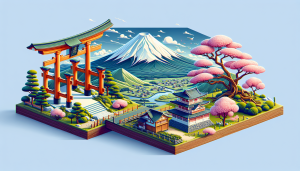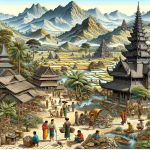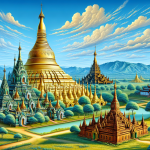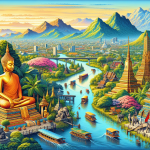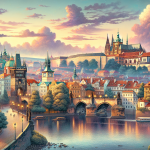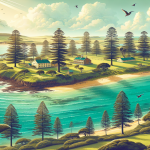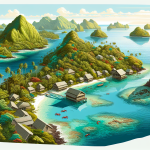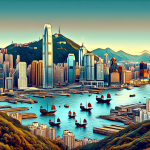Discovering the Wonders of Japan: A Comprehensive Travel Guide
Japan, often referred to as the “Land of the Rising Sun,” is a destination that effortlessly blends the ancient with the modern. From its neon-lit cities brimming with cutting-edge technology to serene temples nestled among lush landscapes, Japan offers a unique travel experience that caters to every type of traveler. This comprehensive guide aims to delve into the multifaceted allure of Japan, providing insights into its rich history, vibrant culture, and the myriad attractions that make it a must-visit destination. Whether you’re planning a short stay or an extended exploration, our detailed overview will help you make the most of your journey through this fascinating country.
Tokyo: A Metropolis of Contrasts
Shibuya Crossing and Shinjuku
One cannot talk about Japan without mentioning Tokyo, the bustling capital city that epitomizes modernity and tradition. **Shibuya Crossing**, often dubbed the world’s busiest intersection, is a sight to behold as waves of pedestrians cross from all directions simultaneously. Nearby, the **Shinjuku district** offers a kaleidoscope of experiences, from high-end shopping and gourmet dining to vibrant nightlife and serene gardens. The **Tokyo Metropolitan Government Building** in Shinjuku provides a free observation deck with breathtaking views of the cityscape.
Asakusa and the Senso-ji Temple
In stark contrast to the ultramodern districts, **Asakusa** stands as a testament to Tokyo’s historical roots. The area is home to the iconic **Senso-ji Temple**, Tokyo’s oldest temple, which dates back to the 7th century. As you approach the temple, you’ll pass through the **Kaminarimon Gate** and stroll down **Nakamise Street**, lined with traditional shops selling everything from local snacks to handmade crafts. This area offers a glimpse into Japan’s past, making it a perfect spot for history enthusiasts.
Kyoto: The Heart of Traditional Japan
Fushimi Inari Shrine
When it comes to traditional Japanese culture, **Kyoto** is the place to be. The city is renowned for its well-preserved temples, shrines, and historic districts. One of the most iconic landmarks is the **Fushimi Inari Shrine**, famous for its thousands of torii gates that form a mesmerizing pathway up the mountain. The shrine is dedicated to Inari, the Shinto god of rice, and features numerous statues of foxes, believed to be Inari’s messengers.
Arashiyama Bamboo Grove
Another must-visit attraction in Kyoto is the **Arashiyama Bamboo Grove**. Walking through the towering bamboo stalks creates an almost ethereal experience, as the sunlight filters through the dense foliage, casting intricate patterns on the path. Nearby, you can visit the **Tenryu-ji Temple**, a UNESCO World Heritage site, and its beautiful garden designed by the famous landscape artist Muso Soseki.
Osaka: The Culinary Capital
Dotonbori and Street Food
**Osaka** is often referred to as Japan’s food capital, and for good reason. The **Dotonbori district** is the heart of Osaka’s culinary scene, famous for its neon lights, bustling atmosphere, and a plethora of street food options. Here, you can indulge in local delicacies like **takoyaki** (octopus balls) and **okonomiyaki** (savory pancakes). The area is also home to iconic landmarks such as the **Glico Running Man** sign, a popular photo spot for tourists.
Osaka Castle
Beyond its culinary delights, Osaka boasts significant historical sites, with **Osaka Castle** being one of the most prominent. Built in the 16th century, the castle played a crucial role in the unification of Japan during the Azuchi-Momoyama period. Today, the castle grounds are a popular spot for cherry blossom viewing in the spring, offering a picturesque setting for picnics and leisurely strolls.
Hiroshima: A City of Peace and Resilience
Hiroshima Peace Memorial Park
**Hiroshima** holds a poignant place in history as the first city to suffer an atomic bombing during World War II. The **Hiroshima Peace Memorial Park** stands as a somber reminder of the past and a symbol of hope for a peaceful future. The park includes the **A-Bomb Dome**, one of the few structures left standing near the bomb’s hypocenter, and the **Peace Memorial Museum**, which provides a comprehensive account of the events and their aftermath.
Miyajima Island
A short ferry ride from Hiroshima takes you to **Miyajima Island**, renowned for its **Itsukushima Shrine** and the iconic floating torii gate. The island is a haven of natural beauty, with lush forests, scenic hiking trails, and friendly deer that roam freely. The view of the torii gate at high tide, appearing to float on the water, is a sight that leaves a lasting impression on visitors.
Hokkaido: Nature’s Wonderland
Sapporo and the Snow Festival
Japan’s northernmost island, **Hokkaido**, is a paradise for nature lovers and outdoor enthusiasts. The capital city, **Sapporo**, is famous for its annual **Sapporo Snow Festival**, which features impressive ice sculptures and attracts visitors from around the globe. The city is also known for its delicious seafood, particularly **crab** and **salmon**, and the world-renowned **Sapporo beer**.
Furano and Biei
For those seeking breathtaking landscapes, a visit to **Furano** and **Biei** is a must. These towns are famous for their rolling hills, vibrant flower fields, and picturesque scenery. In the summer, the **lavender fields** of Furano create a stunning purple canvas, attracting photographers and tourists alike. During the winter months, the area transforms into a snowy wonderland, offering excellent skiing and snowboarding opportunities.
Okinawa: Tropical Paradise
Naha and Shuri Castle
**Okinawa**, a group of islands located in the southernmost part of Japan, offers a tropical escape with its pristine beaches, crystal-clear waters, and rich cultural heritage. The capital city, **Naha**, is home to **Shuri Castle**, a UNESCO World Heritage site that showcases the unique Ryukyu architecture and history. The castle grounds provide a fascinating insight into Okinawa’s past as an independent kingdom before it became part of Japan.
Ishigaki Island and Diving Spots
For beach lovers and diving enthusiasts, **Ishigaki Island** is a paradise. The island is part of the **Yaeyama Islands** and is renowned for its stunning coral reefs, diverse marine life, and beautiful beaches. **Kabira Bay** offers some of the best snorkeling and diving spots, where you can explore the vibrant underwater world and swim alongside manta rays. The island’s laid-back atmosphere and natural beauty make it an ideal destination for relaxation and adventure.
Nagasaki: A Blend of Cultures
Glover Garden and Dejima
**Nagasaki** is a city that has historically served as a gateway for foreign influences, leading to a unique blend of cultures. **Glover Garden** is an open-air museum that showcases Western-style residences from the Meiji era, offering panoramic views of the city and harbor. Another significant site is **Dejima**, a man-made island that served as the sole point of contact between Japan and the outside world during the Edo period. Today, Dejima has been restored to reflect its historical significance, providing a fascinating glimpse into Japan’s period of isolation and subsequent cultural exchange.
Nagasaki Peace Park
Similar to Hiroshima, Nagasaki also experienced the devastation of an atomic bomb during World War II. The **Nagasaki Peace Park** commemorates the tragic event and promotes the message of peace. The park features the **Peace Statue**, a powerful symbol of hope, and the **Atomic Bomb Museum**, which documents the impact of the bombing and the city’s recovery efforts. Visiting the park is a moving experience that underscores the importance of peace and resilience.
Kanazawa: The Hidden Gem
Kenrokuen Garden
For travelers seeking a less crowded but equally captivating destination, **Kanazawa** is a hidden gem that should not be overlooked. The city is home to **Kenrokuen Garden**, considered one of Japan’s most beautiful landscape gardens. The garden features a harmonious blend of water features, bridges, teahouses, and seasonal flora, creating a tranquil oasis in the heart of the city. Each season offers a different spectacle, from cherry blossoms in spring to vibrant foliage in autumn.
Higashi Chaya District
Another highlight of Kanazawa is the **Higashi Chaya District**, a historic area that retains the charm of the Edo period with its well-preserved teahouses and narrow streets. The district is famous for its **gold leaf** production, and visitors can try their hand at making gold leaf crafts or enjoy a cup of gold leaf-adorned tea. The area also offers a variety of shops, galleries, and traditional eateries, providing an immersive cultural experience.
Nara: The Ancient Capital
Todai-ji Temple and Nara Park
**Nara**, Japan’s first permanent capital, is a treasure trove of historical and cultural landmarks. The city is best known for the **Todai-ji Temple**, which houses the Great Buddha (Daibutsu), one of the largest bronze statues in the world. The temple complex is a UNESCO World Heritage site and includes several other significant structures, such as the **Nandaimon Gate** and the **Todaiji Museum**. Adjacent to the temple is **Nara Park**, home to hundreds of freely roaming deer that are considered sacred and are a symbol of the city. Feeding and interacting with these gentle creatures is a delightful experience for visitors of all ages.
Kasuga Taisha Shrine
Another noteworthy site in Nara is the **Kasuga Taisha Shrine**, famous for its hundreds of bronze and stone lanterns that line the pathways. The shrine is dedicated to the deity responsible for the protection of Nara and is surrounded by the **Kasugayama Primeval Forest**, a sacred and ancient woodland. The lanterns are lit twice a year during the **Lantern Festivals**, creating a magical and otherworldly atmosphere.
Mount Fuji: Japan’s Iconic Peak
Climbing Mount Fuji
No trip to Japan would be complete without experiencing the majesty of **Mount Fuji**, the country’s highest and most iconic peak. Climbing Mount Fuji is a popular activity, attracting thousands of hikers each year. The official climbing season runs from early July to early September, when the weather conditions are most favorable. There are several routes to the summit, with the **Yoshida Trail** being the most popular. The ascent typically takes between five to seven hours, with many climbers opting to start their journey at night to reach the summit in time for the breathtaking sunrise.
Fuji Five Lakes
For those who prefer to admire Mount Fuji from a distance, the **Fuji Five Lakes** region offers some of the best vantage points. The area includes **Lake Kawaguchi**, **Lake Saiko**, **Lake Shoji**, **Lake Motosu**, and **Lake Yamanaka**, each providing stunning views of the mountain and opportunities for outdoor activities such as boating, fishing, and hiking. The **Chureito Pagoda** in the nearby town of Fujiyoshida is another popular spot for capturing postcard-worthy photographs of Mount Fuji, especially during the cherry blossom season.
Conclusion
Japan is a land of endless discovery, where every corner reveals a new facet of its rich culture, history, and natural beauty. From the bustling streets of Tokyo to the serene temples of Kyoto, the culinary delights of Osaka to the historical sites of Hiroshima and Nagasaki, Japan offers a diverse array of experiences that cater to all interests and preferences. Whether you’re a history buff, a foodie, an outdoor enthusiast, or simply someone seeking to immerse yourself in a unique and vibrant culture, Japan has something to offer you. As you plan your journey to this incredible destination, remember to embrace the spirit of exploration and take the time to uncover the hidden gems that make Japan truly special.
For more tips on traveling to Japan, including detailed itineraries and practical advice, visit [Japan National Tourism Organization](https://www.japan.travel/en/).
